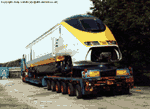
|
A Eurostar power car during delivery to the UK. Some Eurostar stock had to be
delivered for testing in the UK before the Channel Tunnel was opened, and thus travelled
by road and ferry. The power car shown here weighs approximately 68 tonnes.
Photo by Andy Veitch (ajv@sklr.demon.co.uk)
|
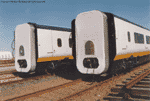
|
Eurostar trailers awaiting delivery at the Alstom (formerly GEC-Alsthom,
formerly De Dietrich) Aytré factory near La Rochelle, France, in 1993.
The Eurostar markings have yet to be applied, and white plastic film protects the
car ends (with an opening for the Scharfenberg couplers, which are used to link the two
halves of a Eurostar).
Photo by Nikolaus Rieskamp (nikolausr@aol.com)
|

|
Eurostar trailers awaiting delivery at the Alstom (formerly GEC-Alsthom,
formerly De Dietrich) Aytré factory near La Rochelle, France, in 1993.
The Eurostar markings have yet to be applied. The trailer ends are supported
by shop bogies and the suspension components protected from the elements by
white plastic film. A special train which will take the
completed trailers to the Alstom factory in Belfort, France for integration
with power cars and end trailers.
Photo by Nikolaus Rieskamp (nikolausr@aol.com)
|
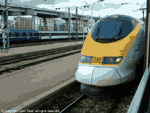
|
Eurostar trainset 3227/3228 in regular SNCF TGV service, seen at Nice Ville on August
4, 2000. This is one of three French Eurostar trainsets that were removed from Eurostar
service to fill demand within France. The doors are redecorated with the conventional
red / aqua blue stripes to identify 1st and 2nd class, and the power cars now sport the
SNCF logo.
Photo by Clem Tillier (ctillier@alumni.princeton.edu)
|
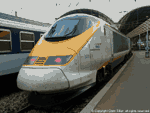
|
Eurostar trainset 3227/3228 in regular SNCF TGV service, seen at Nice Ville on August
4, 2000. Note the SNCF logo which is absent on regular Eurostar trainsets.
Photo by Clem Tillier (ctillier@alumni.princeton.edu)
|
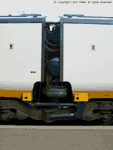
|
Trailer articulation on a Eurostar trainset.
All the features of the SR10 suspension are visible. Round holes in the yellow
section are lifting points. The red indicators lights at the top show the status
of the lavatories, in particular sanitary chemical fluid level.
Photo by Clem Tillier (ctillier@alumni.princeton.edu)
|

|
Bogie of power car 373228 showing 750V third rail pickup shoe.
|
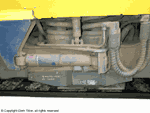
|
Closeup of a 750V third rail pickup shoe on Eurostar power car 373228.
Photo by Clem Tillier (ctillier@alumni.princeton.edu)
|
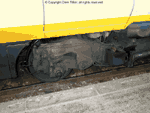
|
Closeup of the last bogie of half trainset 3228 (at the juntion between 3227
and 3228), showing what appears to be a flange greaser.
Photo by Clem Tillier (ctillier@alumni.princeton.edu)
|

|
A Eurostar blasting through the TGV Haute-Picardie station on its way
to London, on 03 September 1996.
Photo by Clem Tillier (ctillier@alumni.princeton.edu)
|
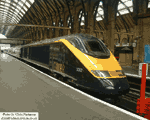
|
A former north of London Eurostar (3300 series) now leased by British rail
operator Great North Eastern Railway (GNER). This Eurostar never sees service
through the channel tunnel or on high speed lines. The GNER livery has been
applied to the trainset using removable adhesive wrap. May 2000.
Photo by Chris Packman (chris@xdinet.demon.co.uk)
|
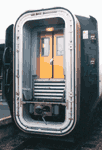
|
For safety reasons in the Channel Tunnel, Eurostar trainsets can be
split in the middle. In case of a derailment or other major fault, this
allows one half of the trainset to exit the tunnel after all passengers
have been transferred to the good half. This photo shows the end of a
half trainset when it is uncoupled from its twin. The passageway between
half trainsets is pressure sealed, and the two halves are coupled together
by a Scharfenberg automatic coupler. (The same type of coupler is used
to link the Eurostar power cars to the half trainset, unlike other TGV
types which use a standard European screw link coupler and buffers)
Photo by Yann Nottara (ynottara@mail.dotcom.fr)
|
![]() Eurostar
Eurostar